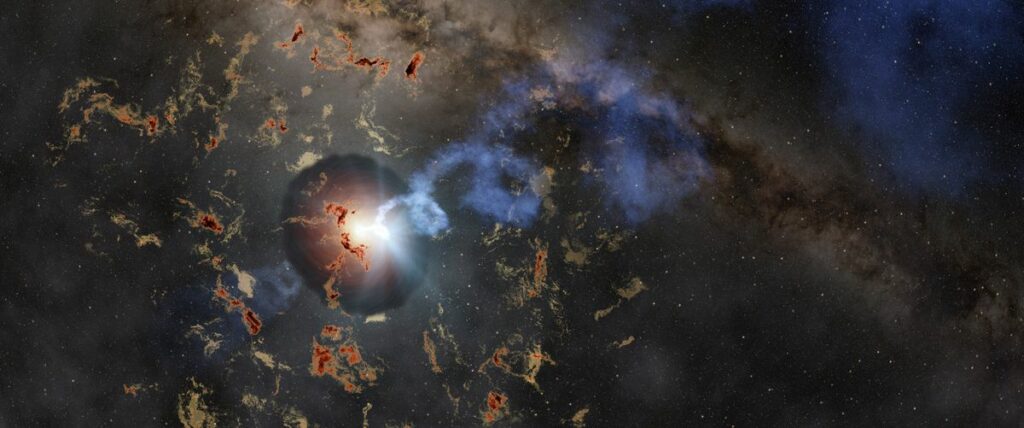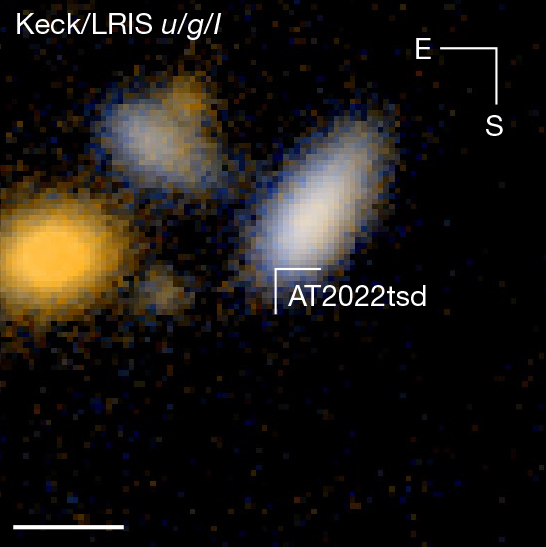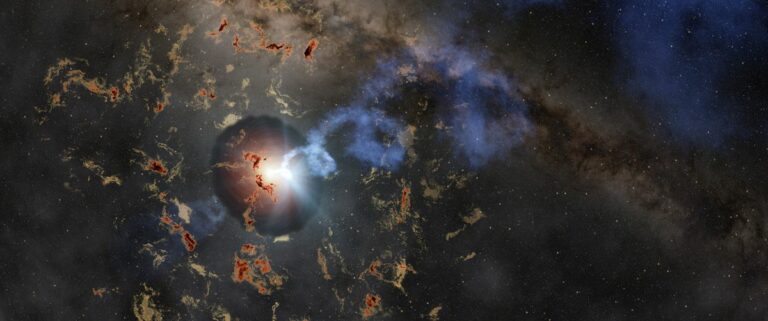Astronomers Uncover a Continuous and Brilliant Explosion in the Cosmos
A dazzling burst of blue light briefly overshadowed its host galaxy before fading away, only to reappear, and repeat the explosive sequence. On September 7, 2022, an automated telescope captured a brilliant blue dot, shining 1,000 times brighter than a typical supernova. This vivid display, labeled as AT2022tsd or the “Tasmanian Devil,” joined the exclusive category of luminous fast blue optical transients (LFBOTs) discovered in 2018. While astronomers initially believed these events to be a unique type of supernova, they could also involve stars torn apart in the intense gravitational fields around neutron stars or black holes.

Caltech / R. Hurt (IPAC)
The real surprise unfolded 100 days later when, in routine image reviews, Anna Ho and her team at Cornell University identified a red-colored burst nearly as bright as the initial blue flare, occurring in the same celestial location. Subsequent investigations uncovered a succession of at least 14 flares, each equivalent in energy release to an exploding star. This unprecedented phenomenon, documented in the journal Nature, marks a groundbreaking discovery in optical flares following explosive transients, providing new insights into cosmic phenomena. Jeff Cooke from Swinburne University of Technology emphasizes that such an event has never been witnessed before, signifying a remarkable and unexpected revelation in the realm of astrophysics.

Keck / LRIS / Ho et al. / Nature 2023
The Zwicky Transient Facility employs the 48-inch Samuel Oschin Telescope and a CCD camera covering 47 square degrees in each image to conduct comprehensive scans of the night sky visible from the Palomar Observatory in California approximately every two days. Utilizing machine-learning algorithms, the system identifies new points of light that emerge, vanish, or shift positions between images.
In the case of the Tasmanian Devil, Zwicky swiftly detected the fading event near a galaxy located 3 billion light-years away. This fortunate alignment aids astronomers in determining the distance of the flare, which would otherwise remain unknown.
Follow-up examinations revealed that while the initial blue light diminished rapidly, the source continued emitting intense radio and X-ray signals for weeks afterward. While the initial blue light likely originated from thermal effects linked to the explosion’s heat, the subsequent radio waves, X-rays, and red-colored flares suggest a different source. It is probable that these emissions result from high-speed electrons navigating strong magnetic fields.
The rapid brightening and fading of follow-on flares, occurring within minutes or as briefly as 20 seconds, indicate a minuscule source, no more than 10 times the width of the Sun, as determined by Ho’s team. The nature of the emissions, coupled with their small size and extreme energies, suggests that the flares emanate from a jet escaping the gravitational pull of a black hole or neutron star at near-light speeds.
This outcome aligns with theories proposing that luminous fast blue optical transients (LFBOTs) involve ongoing accretion of mass by a neutron star or black hole, persisting for months or even years after the initial explosion. While the exact triggers for LFBOTs remain varied, potential scenarios include the collapse of a super-giant star, the merger of a massive star with a neutron star or black hole, or the consumption of a white dwarf by a black hole of substantial mass. All these scenarios have the potential to generate a swift jet of escaping material. The Tasmanian Devil’s unique behavior provides astronomers with a novel avenue to study these celestial events and unravel the mysteries of their origins.
This article is republished from SkyAndTelescope under a Creative Commons license. Read the original article.
Do not forget to share your opinion with us to provide you with the best posts !




0 Comments